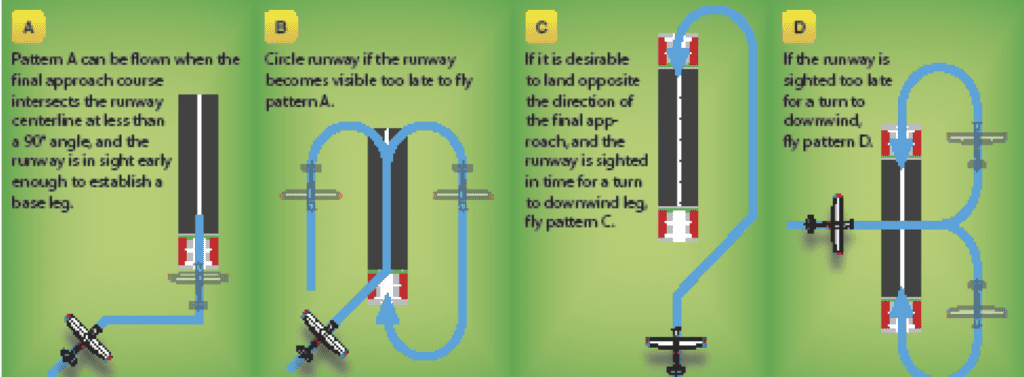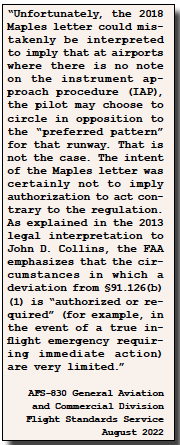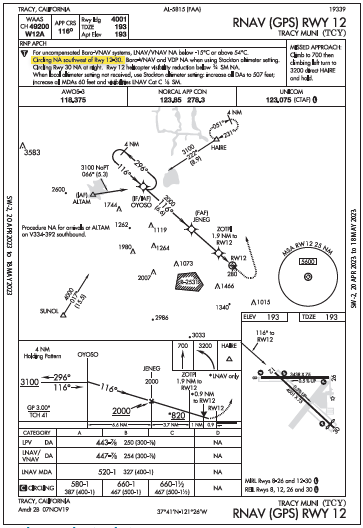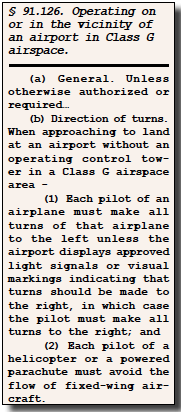Turning in the opposite direction of the regulatory traffic pattern during a circling approach is an almost constant topic of discussion in instrument pilot circles. In “Going Below Minimums” (May 2022 IFR), we wrote:
“At a non‑towered airport the Instrument Flying Handbook in Figure 10‑13 seems to indicate that you can circle in any direction that makes sense. But several legal interpretations have shown that the FAA wants you to circle in the same direction that VFR traffic is required to travel.”
That statement is essentially correct although one can quibble with the way it is phrased. “The same direction that VFR traffic is required to travel” reflects a rather widespread misconception that the traffic pattern regulations do not apply to IFR operations. They do. As we will see, sometimes the FAA contributes to the confusion. Let’s take the opportunity to review the rules and their application.
The Regulations
Let’s begin with Section 91.126 of the Federal Aviation Regulations found in Title 14 of the Code of Federal Regulations. Section 91.126(b)requires fixed-wing traffic landing at non-towered airports in Class G airspace to make all turns to the left unless the airport displays information indicating turns are to be made to the right, in which case right turns is the rule. Section 91.127 applies §91.126 to Class E surface areas. For our IFR circling discussion, it’s important to note there is nothing in §91.126 or §91.127 that limits them to VFR traffic—the direction of traffic rules apply to all aircraft, both VFR and IFR.

The Chief Counsel Weighs In
The application of the traffic pattern regulations to circling approaches was reinforced in a series of FAA Chief Counsel interpretation letters between 2009 and 2014. They are consistent in telling us that the traffic pattern rules apply to IFR flight, and specifically to circling approaches.
In 2009, Daniel Murphy asked whether 91.126(b) “allows a pilot to conduct a circling approach with turns to the right to an uncontrolled airport in instrument meteorological conditions (IMC) if the pilot determines that turns to the left are undesirable.” The FAA legal group was direct in its response: “The use of ‘must’ [in §91.126] does not permit a pilot’s discretion in determining in which direction to make turns when approaching the airport.”
Aside from emergencies, the only door left open was in Class E surface areas. According to Murphy, ATC is permitted to authorize opposite-direction circling at a Class E airport, where ATC has the authority to give instructions. Also, Class E safety concerns are different from those in Class G. Section 91.155(a) requires VFR aircraft to remain 500 feet below and 2000 feet away from any clouds, and §91.155(c) prohibits Class E airport VFR operations entirely (without a Special VFR clearance) when the ceiling is less than 1000 feet. Pilots flying an instrument approach should not be encountering legitimate VFR traffic in the pattern of a Class E airport when those conditions exist.
Practically speaking however, recall that at non-towered airports, ATC doesn’t control pattern traffic; they do not even assign a landing runway when clearing us for an approach. Between variable weather, aircraft with no transponders, and the limitations of radar and ADS-B coverage, they may not even see pattern traffic that low to make a judgment whether it is safe to circle in the opposite direction.
Attempts to have the Chief Counsel’s office reconsider its view have gone nowhere. In 2013 John Collins requested a more liberal interpretation of the words “unless otherwise authorized or required” in §91.126, to allow for more pilot discretion. Nothing doing. The regulatory language, replied the FAA lawyers, means “authorized or required by the approach guidelines of a specific airport or by another FAA regulation.”
Another request for reconsideration in 2014 pointed to the graphic we mentioned above from the Instrument Flying Handbook. The graphic depicts circling approaches going in both directions. Doesn’t that mean circling in any direction is authorized? No. “The diagram is not specific to Class G airspace and should only be considered generally illustrative of possible circling approaches,” responded the Chief Counsel. “It does not provide authorization to make right-hand turns in violation of §91.126(b)(1).”
This view was restated in 2018’s AC 90-66B, Non-Towered Airport Flight Operations update. In its discussion of traffic patterns, the Advisory Circular informs us, “Pilots are reminded that circling approaches must comply with §91.126(b) unless the approach procedure explicitly states otherwise. This has been upheld by prior FAA legal interpretations of §91.126(b).”
The Maples Letter
In response to our restatement of the rule in “Going Below Minimums,” a reader provided a copy of a 2018 letter from Flight Standards to Ken Maples. According to the letter, Mr. Maples asked:
“At airports where there is no note on the instrument approach procedure (IAP) prohibiting circling in one direction or the other, can the pilot choose to circle (due to weather conditions) in opposition to the preferred pattern for said runway?”
The question was similar to John Collins’ earlier question, but the answer was different. Several years ago, the FAA Chief Counsel began referring questions that do not present “a novel legal issue which warrants an interpretation” to the appropriate FAA policy office. In this case, the Chief Counsel referred Mr. Maples’ inquiry to Flight Standards. Their answer:
“If no prohibitions are listed on the IAP regarding which direction to circle,” they wrote to Maples, “the PIC only needs to stay within the circling radii at the appropriate altitude until the aircraft is continuously in a position from which a descent to a landing on the intended runway can be made at a normal rate of descent and using normal maneuvers.”
Oops! Five years of Chief Counsel interpretations and an Advisory Circular were seemingly reversed. We sought clarification from the Chief Counsel and Flight Standards in May 2022, “Intended or not,” we wrote, “the 2018 Flight Standards letter authorizes a pilot performing a circling instrument approach to disregard Part 91 rules regarding the direction of turns in a nontowered airport traffic pattern. It appears to contradict [prior Chief Counsel interpretations and is] directly opposite to Flight Standards’ own statement in AC 90-66B.”
 Our answer came from Flight Standards. The rule remains the same. The Maples letter was not intended to change the answer. Absent an emergency, aircraft performing a circling approach must follow the regulatory traffic pattern rules “unless the approach procedure explicitly states otherwise.”
Our answer came from Flight Standards. The rule remains the same. The Maples letter was not intended to change the answer. Absent an emergency, aircraft performing a circling approach must follow the regulatory traffic pattern rules “unless the approach procedure explicitly states otherwise.”
“Unless Authorized…”
In a brief follow-up, Flight Standards was helpful in answering a related  question. Consider the RNAV (GPS) RWY 12 approach into Tracy, California (KTCY). Tracy uses standard left traffic for all runways. The chart tells us circling southwest of Runway 12-30 is not authorized. Left traffic for Runway 30 is southwest of the runway. Does the prohibition on circling southwest of 12-30 effectively make Runway 30 unusable? Or, does the prohibition on left traffic make right traffic to Runway 30 “authorized or required by the approach guidelines of a specific airport”?
question. Consider the RNAV (GPS) RWY 12 approach into Tracy, California (KTCY). Tracy uses standard left traffic for all runways. The chart tells us circling southwest of Runway 12-30 is not authorized. Left traffic for Runway 30 is southwest of the runway. Does the prohibition on circling southwest of 12-30 effectively make Runway 30 unusable? Or, does the prohibition on left traffic make right traffic to Runway 30 “authorized or required by the approach guidelines of a specific airport”?
Flight Standards said the note authorizes opposite-direction circling. By prohibiting circling to the left, the chart explicitly authorizes, indeed requires, circling to the right. If circling to a hypothetical Runway 27 with circling south not authorized, Flight Standards said, “the approach chart requires that a pilot circling for an approach to Runway 27 avoid circling south of 27. He or she, therefore, may be required to make right traffic to Runway 27 (italics in original).”
Legal But Reckless?
So, yes, circling against the regulatory traffic pattern is legal when the chart prohibits circling in the standard direction.
A note of caution is in order, however. The requirement for all traffic, including IFR traffic, to follow the pattern rules is not only regulatory. It is a safety consideration as well. Class E surface areas, where VFR flight is prohibited if the ceiling is less than 1000 feet, should not be a significant problem if people are following the rules. But what about the Class G airport where Class E begins at 700 AGL? As unusual as it might be in practice, VFR traffic can legitimately operate in that pattern. ADS-B can help, but it is a good operating practice to begin monitoring the CTAF at a non-towered airport early to check for traffic. Even then, circling right downwind is not a good time to meet that NORDO (no radio) Cub legally doing pattern work in the opposite direction.
There is also a remaining regulatory issue. The FAA has successfully brought enforcement actions against pilots who did something technically legal but considered reckless under §91.13. Departing IFR in uncontrolled airspace without a clearance, expecting to reach VFR conditions before entering Class E, is often cited as an example. Chief Counsel interpretations, NTSB decisions in pilot certificate actions and AC 90-66B, all tell us we are obligated not to interfere with traffic in the normal traffic pattern. So don’t be flying opposite the direction of traffic when practicing a circling approach in VFR conditions. Even on an IFR clearance I wouldn’t rely on being “authorized or required” by the approach procedure to fly opposite to VFR aircraft flying a proper regulatory pattern on a good VFR day when I could have comfortably cancelled IFR and joined the party.
Mark Kolber is a CFI and mostly retired aviation lawyer who sometimes wonders where circling approaches fit into Dante Alighieri’s Divine Comedy.





